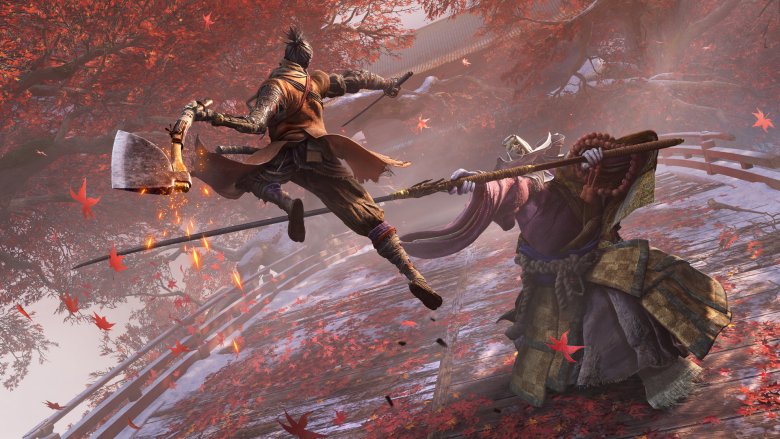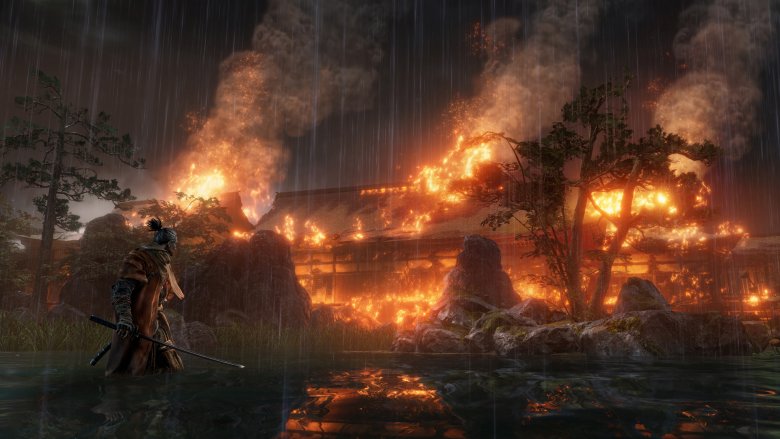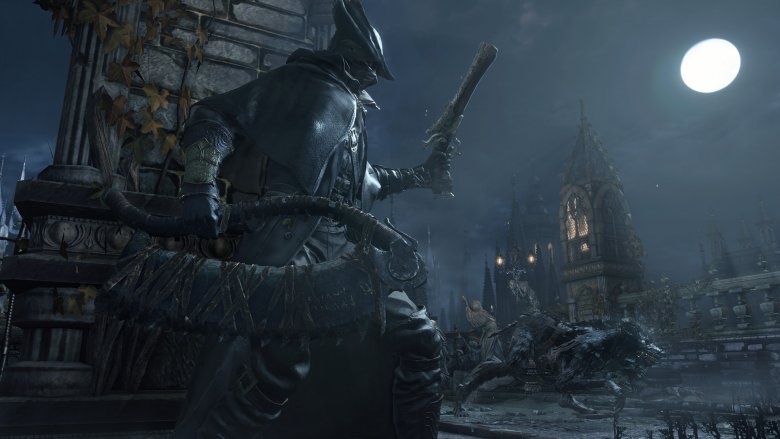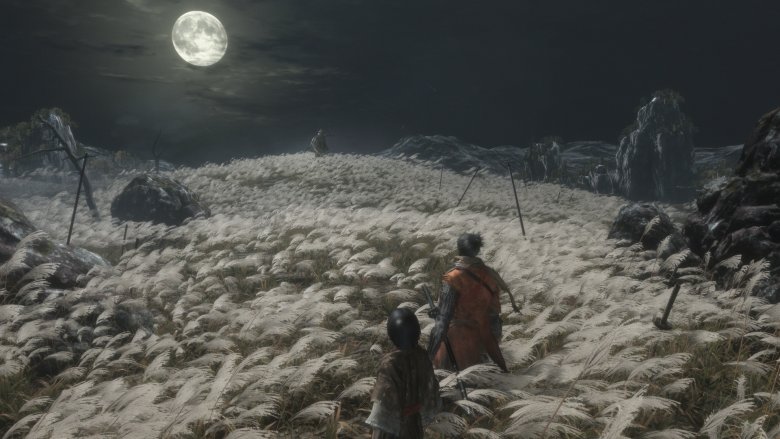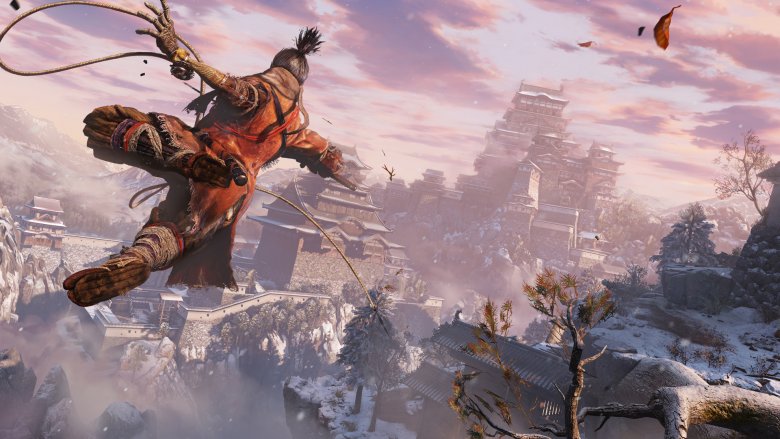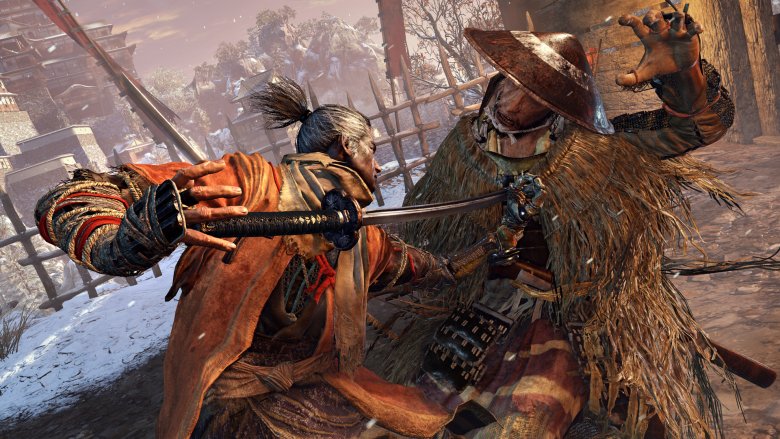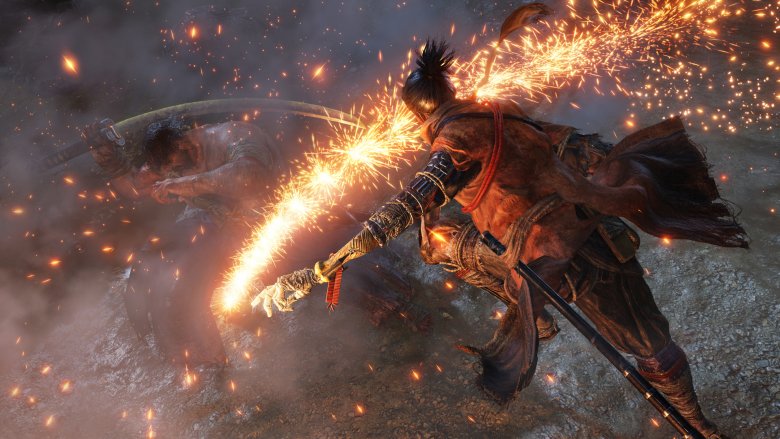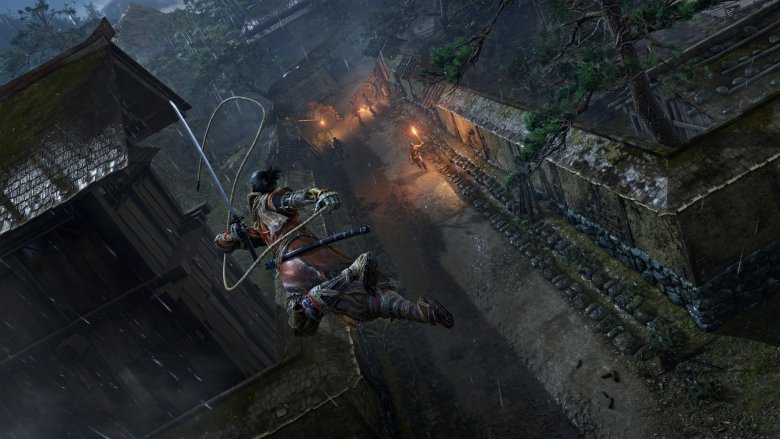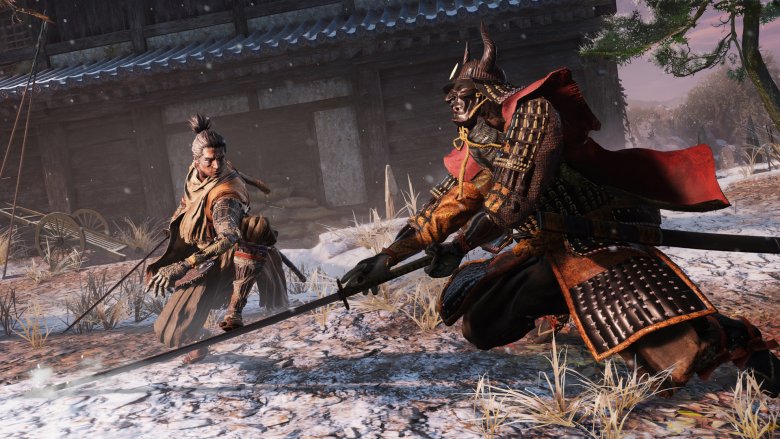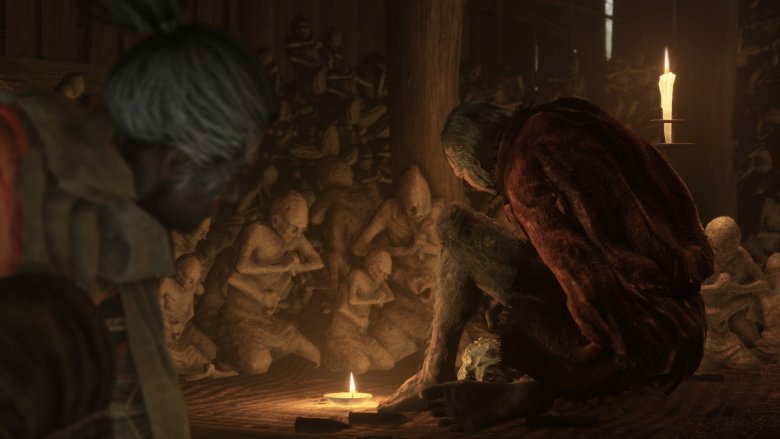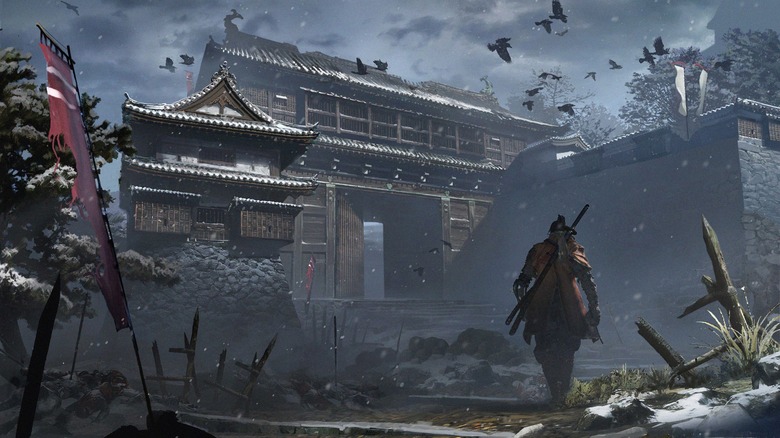Read This Before Buying Sekiro
FromSoftware entered the mainstream consciousness of the gaming industry with its gritty breakout hit, Dark Souls. Despite being around since the mid-1990s, it wasn't until the early 2010s that the company started a new trend. Since the success of the company's spiritual successor to Demon's Souls, many "Souls-Like" games have popped up, such as The Surge and Nioh. But the masters of tough-as-nails action-RPGs are back with a new game called Sekiro: Shadows Die Twice.
Sekiro first came to light at E3 2018, with a flashy trailer showing off some frantic samurai action. While director Hidetaka Miyazaki has made it clear that Sekiro has no ties to From's previous titles, there's a lot we can glean from looking at the Souls series and their cousin title Bloodborne. In fact, much of the excitement for this upcoming title stems from the proven quality of its predecessors. If you look up any hands-on previews about Sekiro, chances are people will discuss it through the lens of the Soulsborne games.
Sekiro will sneak onto the PlayStation 4, Xbox One, and Windows on March 22. Read on to find out more about the ninja's epic journey.
Why you should keep an eye on Sekiro
If you haven't played Dark Souls or Bloodborne, you might be out of the loop regarding the hype behind Sekiro. Through the aforementioned games, From demonstrated its impeccable understanding of heart-pounding combat. Now the developers are applying all they've learned to the more fast-paced fighting style of a shinobi. Dark Souls continued the groundwork laid by Demon's Souls, refining the slow but steady sword-and-shield combat. Bloodborne offered a change of pace, rewarding the player for aggression, and this change was well received by critics and fans alike.
Sekiro amps that frantic aggression to new levels. Players don't get a shield, having to rely purely on dodges and parries to avoid damage. Additionally, the movement goes beyond Bloodborne's with the addition of verticality. Perhaps the most interesting change in Sekiro involves the new setting. The Soulsborne series has primarily explored European-inspired settings, albeit twisted versions of them. Unlike Dark Souls' dark medieval fantasy or Bloodborne's gothic aesthetic, Sekiro explores feudal Japan.
The upcoming game uses the Sengoku Era as the backdrop for the story, a period in Japanese history steeped in blood and warring factions. You can expect to see weapons and armor that fit the time period, like katanas and naginatas. However, you should also be prepared for some supernatural hijinks to ensue, like skeleton samurai and giant snakes.
What's so great about Soulsborne games
If you've given the Soulsborne games a chance, one thing should be clearly evident: they aren't for the faint of heart. Even the most insignificant foe has a good chance of killing you, and as you'd imagine, the bosses pose a nearly insurmountable threat. Dying over and over again doesn't necessarily sound fun, which video games should be.
But it's in those moments that From challenges you to become a better player. You learn your enemies' attack patterns, one death at a time. When you finally emerge victorious, the endorphin rush can't be matched. The Soulsborne titles are full of intrinsic rewards, where the sense of accomplishment can outweigh whatever loot you get.
Under this system lies ingenious level design. Each level is built around a handful of checkpoints. Then it's up to you to find shortcuts throughout the world, thereby connecting one checkpoint to many destinations. You carve your own path through the world, earning the convenience through your own hard work.
From trusts you as a player to find your own fun in its games. It even trusts you to find the deep lore, which isn't made readily apparent in the Soulsborne games. By shirking off any hand holding, these titles offer an environment where every gritty struggle rewards players. From clearly accomplished a lot with its previous four games, so all eyes are on Sekiro now to continue the streak.
Sekiro: The One-Armed Wolf
Unlike the Soulsborne games, Sekiro surprisingly has a more established narrative from the start. Rather than creating a character, you play as a defined person, and he goes by a few names, such as Shinobi and the Wolf. In fact, the two Japanese characters that make up the word "Sekiro" roughly translate to "the one-armed wolf."
The Wolf has to guard a ten-year-old prince, known as the Divine Heir, but the leader of the Ashina Clan kidnaps the child for his magical blood. In the process, he severs your character's left arm. The Wolf wakes up with a new arm called the "Shinobi Prosthetic," which can be outfitted with an assortment of gear. With his katana in hand, the Wolf sets off to rescue the boy on a journey that will have him fight samurai and demons alike. To top it all off, an unnamed cult lurks beneath the surface, and its goals are unclear.
By placing the player in the shoes of a predefined character, the story will likely be more involved than the Soulsborne games. The cast surrounding the Wolf react to him, and he reacts back, which goes further than the mostly silent protagonist of Dark Souls. However, Miyazaki assures us that the more ambient storytelling of the past games won't be lost. Players can still explore for extra clues about the narrative, widening the understanding of the story as it unfolds.
Take to the skies
The Wolf might be the most mobile protagonist in a From game in recent memory. For one, he can actually jump. If you've played a Soulsborne game before, you know how big a deal that is. Your knight in Dark Souls couldn't jump without a running start, and the same goes for your hunter in Bloodborne. This inherent lack of vertical movement deeply affected the level design. More often than not, short drops acted as a one-way passage, segmenting different sections of the level. However, Sekiro turns that concept on its head, where verticality suddenly has less finality to it. Combine that with no fall damage, and the traversal opens up more than any Soulsborne game ever could.
The Wolf also comes equipped with a grappling hook, which is part of his Shinobi Prosthetic. The hookshot complements the new jumping mechanic, extending his vertical and horizontal reach. Additionally, it provides a new layer to your approach to combat. In some cases, you can use the hookshot to reach a new part of the map, sneaking around enemies to get the drop on them. In other cases, a quick use of the hook can save your life in the midst of a grueling battle by offering a new method of escape.
Who needs stamina when you have posture?
Both Dark Souls and Bloodborne made use of a stamina system. Almost every action, such as swinging your weapon or dodge rolling, takes up a chunk of stamina. Run out of it and you won't be able to do anything until it regenerates. Needless to say, maintaining your stamina is a key part of staying alive in these games. That green bar created a hit-and-run mentality in the Soulsborne titles, encouraging a few quick hits followed by a graceful retreat to catch your breath.
Sekiro throws that out the window in favor of a new system. Called posture, this bar depletes whenever you take a hit. Blocking a hit chips away at the resource, and full-on attacks take away even more. Your best bet is completely dodging an enemy's attack, but if you like taking risks, try parrying an enemy. A perfect parry, which requires good timing, retains your posture while dealing damage to your opponent's posture.
That's right, every enemy you face has their own posture meter as well. Every time you land a hit using your katana or your tricky Prosthetic Tools, you chip away at their posture. When they run out of it, you can execute what the game calls a Shinobi Death Blow, which takes away a sizeable chunk of your opponent's health. Sekiro players will benefit from a measured yet aggressive playstyle unlike any Soulsborne game.
Shadows (and Shinobi) die twice
Sekiro: Shadows Die Twice takes its name pretty literally. You play as a ninja nicknamed the (One-Armed) Wolf, and he moves through shadows to get the drop on opponents. On top of that, he literally dies twice. When your health hits zero, you die, as you'd expect. However, the game gives you a moment to revive yourself, giving you another chance. So with every life, you can die twice.
The system ingeniously lets you use it to play with your opponents. Once you die, your killer starts walking away. After all, what would they gain from standing around while watching a corpse? After they've turned away, you can resurrect and strike back, exploiting the element of surprise that ninjas love to use.
However, getting another lease on life doesn't necessarily mean Sekiro will be an easier journey than Dark Souls. In an interview with the US PlayStation Blog, Miyazaki stressed that the upcoming title will still be rigorously difficult: "There's one thing I'd like to make sure isn't misunderstood: the resurrection system was not introduced to make the game easier," he said. "If anything, it actually can make the game harder because it allows us to push the edge of risky combat where the player can die at any moment."
No souls, no problem
In another change from the Soulsborne games, Sekiro has doesn't have one central currency, like Souls or Blood Echoes. Killing enemies nets you some experience, and every enemy now drops some gold. Experience earns you skill points, which you use to purchase abilities from three different skill trees: Shinobi, Ashina, and Prosthetic Arm. These skill trees are unlocked as the player progresses through the world and finds specific items. Your health or posture meters can be upgraded with every four Prayer Beads you collect. However, only the toughest of enemies drop the rare resource.
This new system serves as a drastic change from the more passive upgrading of the Soulsborne games. In those, you collect Souls, which acts as experience and money. They could either improve your core stats (strength, dexterity, and so on) or buy items from vendors.
Sekiro separates experience and currency, but you do lose half of both upon death. If you're lucky, a feature called "Unseen Aid" can trigger, saving all your resources. While it's more lenient than the previous games' complete loss, there's a new kind of consequence to death. The more you die, the more a disease called "Dragon Rot" spreads throughout the world, afflicting the NPCs you talk to. This change in the narrative also affects the gameplay, as more deaths also lowers the chances of triggering an Unseen Aid.
A truly single-player experience
Multiplayer, another core component of the Soulsborne formula, won't appear in Sekiro. Previously, players could summon others, and together they could slay difficult monsters together. If a boss gave you trouble, you could summon an extra pair of hands to make the experience easier. And for the more feisty warriors, you could participate in player-versus-player fights. These battles test your skills in combat as well as your choice in gear.
But Sekiro opts for a completely solo approach. Despite the instincts of the animal he was named after, the Wolf works alone. The challenge of conquering a From game without any help might sound scary, but it's not all bad. At least in Sekiro, you won't need to worry about player invasions as you explore this demonic envisioning of feudal Japan.
In fact, designing a purely single-player experience has freed the developers' creative minds when it comes to level design. Yasuhiro Kitao, the manager of marketing and communications at From, explained that the developers didn't need to worry about players breaking the game's levels via cooperative play: "So it allows us, again, to hone in on the player experience, and really capitalize on that lack of restriction that comes with creating a multiplayer-based game, and let our imagination run wild in these places."
Collectable statues and coins
Sekiro: Shadows Die Twice launches on March 22 at a retail price of $60. Amazon offers an exclusive Steelbook for PS4, Xbox One, and PC purchases at no extra cost. If you're interested in pre-order bonuses, three storefronts offer some extra goodies: GameStop provides a katana-shaped letter opener, digital pre-orders through the Microsoft Store net you two Xbox Live avatar items, and digital pre-orders on the PlayStation Store come with a dynamic Sekiro theme for your PS4.
If you were quick to the draw, you might have already secured your copy of the Collector's Edition of the game, which is exclusively available through GameStop. That version comes with an 8" statue of the Wolf, along with a map, an artbook, and three replica coins, like the ones used in Sekiro. You'll also get access to the digital soundtrack. To top it all off, the game comes with a Steelbook, covered in different art from the Amazon Steelbook mentioned above. Unfortunately, at the time of writing, online orders of the Collector's Edition have sold out.
What the critics are saying about Sekiro
Thoughts are starting to pour in for Sekiro: Shadows Die Twice, and if you've been looking forward to this one, we have some great news for you. This isn't a Souls game. This isn't a sequel to Bloodborne. Yet the talented people at FromSoftware have managed to create something spectacular anyway. And really, it's probably time to stop being surprised at this point.
Here's what everyone is saying.
IGN's Brandin Tyrrel: "Sekiro: Shadows Die Twice is a stylish, focused stealth-action take on the FromSoftware formula that evolves in a different and refreshing direction. It may be a bit easier than a Souls game, but it's something amazing all its own." Score: 9.5/10
GameSpot's Tamoor Hussain (in-progress): "Sekiro marries FromSoftware's unique brand of gameplay with stealth-action to deliver an experience that is as challenging as it is gratifying. At the time of publish I haven't completed Sekiro. While I have invested upwards of 30 hours into it, there are still a few more locations I need to explore and bosses I need to beat before the credits roll, and I'm excited to do it." Score: 9/10
Polygon's Dave Tach and Jeffrey Parkin (in-progress): "I have to put in a lot of work and effort to meet Sekiro on its own terms, but what might feel ponderous in a lesser game becomes rewarding in one created with this much care. Sekiro meets me with just as much effort and enthusiasm as I've put into it. It lets me know I'm capable and skilled, and that I can figure it out. And then it hands me my ass again." Polygon Recommends
USgamer's John Learned (in-progress): "This is a wildly different experience — it rejects mechanics sacrosanct to [Souls] games, stamina meters in particular, in favor of faster combat that's maybe only one step removed from a good 3D fighting game. Little hints and echoes to FromSoft's past output is in there for those looking hard, but Sekiro is its own one-armed animal."
Destructoid's Chris Carter (in-progress): "Sekiro: Shadows Die Twice innovates to the point where people who are tired of the same old song and dance will find new mysteries to master, but still maintains that strong marriage of world building and sense of pride garnered from besting taxing conflicts. It's another keeper so long as you're ready to strap in for a tough ride."
VG247's Kirk McKeand: "Sekiro is a game a lot of people are going to bounce off. It's one for the 'git gud' crowd – for people who want a feeling of accomplishment, rather than the fake achievement you feel from finding some Level 20 Pants in most modern triple-A experiences. It's FromSoftware at its most confident, at its most unapologetic. It's Bloodborne but faster, with fewer crutches yet somehow more fair. It's also one of the best games released so far in what's already looking like a strong 2019."

